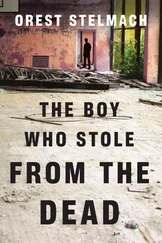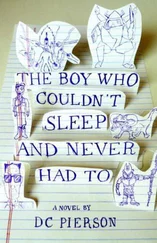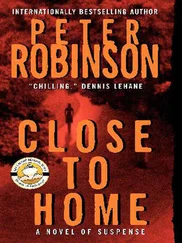To combat the cold the old lady spends her days in bed, kitted out in balaclava and mittens, under a heap of eiderdowns, blankets, and overcoats that she gets the boy to pile over her before he leaves the house. There she lies right around the clock, reading the papers by day, dozing by night, rising only to cook the boy his porridge in the mornings and his fish tail and potatoes at night, to wring out his clothes and her own, to iron and darn, mop the damp from the floors and walls, and puff her way through thirty cigarettes.
And since the young mistress and her elder daughter fell ill, the old lady has been popping downstairs to cook for the landlord and his younger children; to nurse the patients, wash their clothes, and boil their compresses and rags.
Never in all her born days can the old lady recall spending so much time lounging around in bed.
* * *
There’s the boy now, climbing the ladder to the attic.
A sequence that he has been trying to shake off for the last hour keeps repeating itself over and over in his mind:
A horse-drawn carriage careers at breakneck speed down the slope of Bakarabrekka, over the bridge, and into Lækjartorg Square. The dwarfish driver is bound to the box with a broad leather strap. His head is encased in a black turban, the long end muffling his face; his gleaming black eyes flick to and fro beneath immensely bushy brows. He brandishes his whip like a madman, raining down the lash on the horses’ flanks, and they stretch out their necks at a gallop, snorting till they foam at the bits.
On the roof of the carriage stands a female figure in a long cloak that flaps in the wind like a huge bat spreading its wings. With the razor-sharp, nine-inch claws on her half-human hands, the creature rips open the carriage roof, sending splinters of wood flying like hail into the louring black night.
Two men are sitting inside, one young, the other older. Overcome with terror, the older man cowers against the younger.
The boy appears in the opening at the top of the ladder.
Only once he has emerged onto the landing does he mentally pause the footage, freezing it on a tight frame of the older man’s fleshy hand clutching at the younger man’s thigh. The thick fingers dig into the pale-colored trouser material, the middle one sporting a gold ring embellished with a large gem.
The boy looks across the attic.
A candle is burning on the stool beside the old lady’s bed: she’s awake, then.
Becoming aware of him, she sits up.
The boy freezes in his tracks.
Before his eyes, sixty years fall away from the old lady. Her features are softened by the yellow glow of the guttering flame and the rust-brown balaclava frames them like a loose fall of hair.
She takes on the appearance of a woman the boy has not seen for many a long year, becoming the living image of her youngest sister’s granddaughter.
The boy sinks to the floor with a groan.
— Mother …
The stairway up to the projectionist’s booth is like a shaft supplying oxygen to a blazing furnace.
The boy clings to the rail, struggling to resist the force that is sucking him inexorably closer. He leans back until he is almost horizontal, bracing his feet against the steps as if the world is standing on end and he is fighting to climb backward up the stairs that lead straight down into the fiery mouth of the oven.
It crosses his mind that it would be easier to crawl away than to reverse, but when he turns he is hit head-on by the blast, loses his grip on the rail, and is flung with colossal force up the steps and in through the door of the projectionist’s booth.
The booth is filled with an ear-splitting noise and a searing inferno.
The projector is as big as a horse, its reels like wagon wheels, the car engine that drives it glowing red with the strain. The lamp is as dazzling as the sun; blinding light shines out of every chink in the machine.
The projectionist is pacing around the booth, striking his clenched fist into his palm. He is drenched with sweat, which sprays from him at every turn he takes. From where the boy is lying in a huddle by the door, he can see the drops sizzling on the scalding metal, evaporating and leaving behind tiny rings of salt.
The boy himself is burning up. He opens his mouth in the hope that some of the sweat will find its way inside.
The man stops dead when he notices the gaping boy. He points at the wall in front of the projector. The wall is intact where the opening for the light-beam should be. The picture projected onto it is no bigger than a postcard.
When the boy doesn’t react, the man raises him to his feet, leads him in front of the thundering machine, and stations him so the film is projected onto his chest.
The heat close to the machine is even more suffocating than over by the door, and the boy chokes as he breathes in the blistering air.
He begins to cough.
* * *
The film on his chest shows a close-up of gas blowing out of a heating vent in an opulently papered wall. Cut to smartly dressed guests in a ballroom. Close-up of the gas smoking out of the vent on his breastbone. Cut to men and women running around in confusion. Close-up of the smoking gas. Cut to the guests beating on the locked doors. Close-up of the gas. Cut to the guests trying to break into the boy’s lungs. Close-up of the gas. Cut to the guests lying comatose. Cut to black-clad criminals in gas masks, who steal into the ballroom, out from between the boy’s ribs.
* * *
The more the boy coughs, the hotter he becomes.
The projectionist shouts to him over the thundering of the engine, then begins to strip off his clothes. When he has removed every last stitch apart from a green woolen kneesock on his right leg, the lights go on in the gymnasium adjoining the booth. A rock the height of a man, made of moon-pale stone, stands in the middle of the floor.
The projectionist waves to the boy and bounds into the gym. Giving the rock a measuring look, he limbers up, stretches, flexes his biceps, sizes up the rock again, then heaves it over his head and tosses it some ten yards with ease. Then, strolling after it, he repeats the trick again and again.
This is accompanied by tremendous crashes.
The coughing boy gets a hard-on.
The boy is standing in the doorway of a storeroom.
A human figure, swathed in black from head to foot, is leaning against a large wooden box. Around its waist is a black chain that falls heavily over its loins. The box comes up to the figure’s middle. Beneath the hem of its skirt the toe of a shoe peeps out.
— A little closer, dear, a little closer …
The tinny voice emanating from inside the box sounds like a scratched gramophone record.
— A little closer, dear, a little closer …
The floorboards glisten. Ropes of gray slime stretch out like the filaments of a net from the toe under the skirt across the room to the boy’s bare feet.
— A little closer, dear, a little closer …
* * *
The black garment billows — something is moving inside, from the hips up the body to the head and back down the same way — until the figure thrusts two clenched, gloved fists out through the slits in the middle.
— A little closer, dear, a little closer …
The gloved fists open. Each contains a handful of flesh: cheeks, firm and ruddy, with smooth skin and a hint of dimples. It seems to the boy as if they have been ripped from his own face.
— A little closer, dear, a little closer …
The cheeks are slapped down, side by side, on the lid of the box.
— A little closer, dear, a little closer …
The hands disappear inside the slits. The garment billows.
Читать дальше












